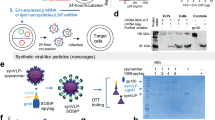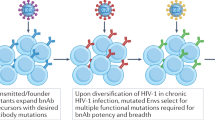Abstract
By comparing HIV-1 variants from people who became infected at the beginning of the epidemic and from people who have recently contracted the virus, we observed an enhanced resistance of the virus to antibody neutralization over time, accompanied by an increase in the length of the variable loops and in the number of potential N-linked glycosylation sites on the HIV-1 envelope gp120 subunit. The enhanced neutralization resistance of HIV-1 in contemporary seroconverters coincided with the poorer elicitation of neutralizing antibody responses, which may have implications for vaccine design.
This is a preview of subscription content, access via your institution
Access options
Subscribe to this journal
Receive 12 print issues and online access
$209.00 per year
only $17.42 per issue
Buy this article
- Purchase on Springer Link
- Instant access to full article PDF
Prices may be subject to local taxes which are calculated during checkout


Similar content being viewed by others
References
Richman, D.D., Wrin, T., Little, S.J. & Petropoulos, C.J. Proc. Natl. Acad. Sci. USA 100, 4144–4149 (2003).
Bunnik, E.M., Pisas, L., van Nuenen, A.C. & Schuitemaker, H. J. Virol. 82, 7932–7941 (2008).
Rong, R. et al. J. Virol. 81, 1350–1359 (2007).
Sagar, M., Wu, X., Lee, S. & Overbaugh, J. J. Virol. 80, 9586–9598 (2006).
Chackerian, B., Rudensey, L.M. & Overbaugh, J. J. Virol. 71, 7719–7727 (1997).
Wei, X. et al. Nature 422, 307–312 (2003).
Kawashima, Y. et al. Nature 458, 641–645 (2009).
Lambert, J.S. et al. J. Infect. Dis. 175, 283–291 (1997).
Euler, Z. et al. J. Infect. Dis. 201, 1045–1053 (2010).
Keele, B.F. et al. Proc. Natl. Acad. Sci. USA 105, 7552–7557 (2008).
Salazar-Gonzalez, J.F. et al. J. Exp. Med. 206, 1273–1289 (2009).
Pinter, A. et al. J. Virol. 78, 5205–5215 (2004).
Laird, M.E., Igarashi, T., Martin, M.A. & Desrosiers, R.C. J. Virol. 82, 11054–11065 (2008).
Gray, E.S. et al. J. Virol. 81, 6187–6196 (2007).
Acknowledgements
The Amsterdam Cohort Studies on HIV infection and AIDS, a collaboration between the Amsterdam Health Service, the Academic Medical Center of the University of Amsterdam, Sanquin Blood Supply Foundation, the University Medical Center Utrecht and the Jan van Goyen Clinic are part of The Netherlands HIV Monitoring Foundation and are financially supported by the Center for Infectious Disease Control of The Netherlands National Institute for Public Health and the Environment. This study was financially supported by the Dutch AIDS fund (grant 2004064), The Netherlands Organization for Scientific research (grant 918.66.628), an Academic Medical Center graduate school PhD scholarship (M.R.A.W.), the European Community's Six Framework Programme European HIV Enterprise (EUROPRISE; FP6/2007–2012) under grant agreement 037611 and the European Community's Seventh Framework Programme Next Generation HIV-1 Immunogens inducing broadly reactive Neutralizing antibodies (NGIN) (FP7/2007–2013) under grant agreement 201433. We thank the International Antiviral Therapy Evaluation Center for providing financial support for the follow-up of contemporary seroconverters, D. Burton and A. Hessell (The Scripps Research Institute) for their generous supply of IgG1b12, D. Katinger (Polymun, as a partner in EUROPRISE) for his supply of mAbs 2G12, 2F5 and 4E10, and D. Montefiori (Duke University Medical Center) for his supply of HIVIg. The following reagents were obtained through the US National Institutes of Health AIDS Research and Reference Reagent Program, Division of AIDS, National Institute of Allergy and Infectious Diseases: HIV-IG from North American Biologicals and the National Heart, Lung, and Blood Institute.
Author information
Authors and Affiliations
Contributions
E.M.B. designed the study, performed experiments, analyzed data and wrote the manuscript; Z.E. performed experiments and analyzed data; M.R.A.W. performed part of the sequence analyses; B.D.M.B.-N. performed part of the neutralization experiments; M.L.G. and J.M.P. selected and recruited individuals for the contemporary seroconverter cohort and contributed samples and data of these subjects; and H.S. designed the study, supervised the project and wrote the manuscript.
Corresponding author
Ethics declarations
Competing interests
The authors declare no competing financial interests.
Supplementary information
Supplementary Text and Figures
Supplementary Figures 1–3, Table 1 and Methods (PDF 161 kb)
Rights and permissions
About this article
Cite this article
Bunnik, E., Euler, Z., Welkers, M. et al. Adaptation of HIV-1 envelope gp120 to humoral immunity at a population level. Nat Med 16, 995–997 (2010). https://doi.org/10.1038/nm.2203
Received:
Accepted:
Published:
Issue Date:
DOI: https://doi.org/10.1038/nm.2203
This article is cited by
-
Codon optimization and improved delivery/immunization regimen enhance the immune response against wild-type and drug-resistant HIV-1 reverse transcriptase, preserving its Th2-polarity
Scientific Reports (2018)
-
The HIV-1 transmission bottleneck
Retrovirology (2017)
-
The V1 region of gp120 is preferentially selected during SIV/HIV transmission and is indispensable for envelope function and virus infection
Virologica Sinica (2016)
-
Partial rescue of V1V2 mutant infectivity by HIV-1 cell-cell transmission supports the domain’s exceptional capacity for sequence variation
Retrovirology (2014)
-
HIV-1 envelope glycoprotein signatures that correlate with the development of cross-reactive neutralizing activity
Retrovirology (2013)



